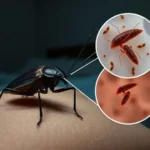Introduction: A Discovery That Changed Marine Reptile History
A near-complete skeleton uncovered along Dorset’s famous Jurassic Coast has rewritten the story of prehistoric oceans. The fossil, now named Xiphodracon goldencapensis, translates to “sword dragon of Dorset” — an apt name for this remarkable marine reptile. The find represents not only a new species of ichthyosaur but also one of the most complete specimens ever found from a crucial evolutionary period around 185 million years ago.
Paleontologists describe this discovery as a “missing puzzle piece” in understanding ichthyosaur evolution — the dolphin-like predators that once dominated the seas while dinosaurs ruled the land.
The Jurassic Coast: A Window into Earth’s Deep Past
The Jurassic Coast, stretching across Dorset and East Devon in southern England, is a UNESCO World Heritage Site known for its breathtaking cliffs and fossil-rich landscapes. This coastline tells a 185-million-year-long story of Earth’s geological history — from the Triassic through the Jurassic and into the Cretaceous period.
It was here, amid the shifting sands and eroding cliffs, that fossil hunter Chris Moore stumbled upon something extraordinary in 2001: a nearly complete skeleton of an ichthyosaur at Golden Cap, the highest point on England’s south coast.
The discovery would later become one of the most important marine reptile finds of the 21st century.
Unearthing the Sword Dragon of Dorset
When Moore uncovered the fossil, he immediately recognized its significance. The specimen was later transferred to the Royal Ontario Museum in Canada, where experts could conduct detailed preservation and analysis. For over 15 years, scientists meticulously examined every bone and fracture before identifying it as a new species.
In 2025, a research paper led by Dr. Dean Lomax, an ichthyosaur expert from the University of Manchester, officially introduced the world to Xiphodracon goldencapensis — a species unlike any other.
What Makes Xiphodracon Unique
The ichthyosaur measured around 3 meters (roughly 10 feet) in length and exhibited several unique anatomical features. Among the most striking was its elongated, sword-like snout, which inspired the name “sword dragon.” Scientists believe it used this snout to hunt small fish and squid, striking with speed and precision in the shallow Jurassic seas.
Another oddity was a prong-like bone near the nostril, a feature unseen in any other known ichthyosaur. Its enormous eye sockets indicate exceptional vision — a vital trait for navigating dark or murky waters.
According to Dr. Lomax:
“Xiphodracon translates to sword-like dragon, a nod to its long, slender snout and the fact that ichthyosaurs have been called sea dragons for over 200 years.”
A Glimpse into Ichthyosaur Evolution
Ichthyosaurs first appeared about 250 million years ago, thriving in the world’s oceans for more than 150 million years. They resembled modern dolphins or swordfish, with sleek bodies built for speed and endurance. Yet despite their dominance, many species — including Xiphodracon — went extinct long before the end of the dinosaurs.
During the early Jurassic period, ichthyosaurs were diversifying rapidly, evolving new hunting strategies and body shapes. Fossils from this time are rare, making the “sword dragon” invaluable for understanding how these creatures adapted and survived after mass extinction events.
Dr. Lomax noted:
“During this period, ichthyosaurs are incredibly rare, and Xiphodracon is the most complete individual ever found from that time. It fills a vital evolutionary gap.”
The Tragic Death of the Sword Dragon
Fossilized bones often tell stories of both life and death. The Xiphodracon specimen revealed gruesome details — its limb bones and teeth were malformed, suggesting injuries or diseases during its lifetime. More strikingly, marks on the skull indicate it was likely bitten by a much larger predator, possibly another ichthyosaur.
Dr. Erin Maxwell from the State Museum of Natural History Stuttgart, co-author of the study, explained:
“The skull appears to have been bitten by a large predator — probably another, much larger species of ichthyosaur. Life in the Mesozoic oceans was perilous.”
These bite marks provided rare forensic evidence of predator-prey behavior among marine reptiles.
Life in the Mesozoic Oceans
The early Jurassic oceans were teeming with life — from ammonites and belemnites to giant pliosaurs and marine crocodiles. Ichthyosaurs ruled the mid-tier predatory niche, feeding on smaller fish and squid. Their streamlined bodies and powerful tails allowed them to travel vast distances, much like modern whales.
But these oceans were also battlegrounds. Predatory encounters, diseases, and fluctuating sea levels made survival a challenge. The “sword dragon” serves as a snapshot of that brutal ecosystem.
Mary Anning and the Birthplace of Paleontology
No discussion of Dorset fossils is complete without mentioning Mary Anning, the pioneering 19th-century paleontologist who first discovered ichthyosaur fossils along this very coast. Her groundbreaking work helped establish the field of vertebrate paleontology.
More than 200 years later, her legacy continues with discoveries like Xiphodracon goldencapensis, reinforcing Dorset’s reputation as the birthplace of marine reptile research.
From Discovery to Museum Display
After its excavation, the fossil was carefully transported to the Royal Ontario Museum (ROM), where a specialized team undertook the painstaking process of preparation and reconstruction. Fossils often require years of cleaning, stabilizing, and comparing against known specimens.
It took over 15 years for the research team to fully identify the differences between Xiphodracon and other ichthyosaurs. The process involved 3D scanning, digital reconstruction, and comparative anatomy, blending traditional paleontology with modern technology.
The Man Behind the Discovery: Chris Moore
Fossil hunter Chris Moore, who discovered the specimen, has found around 15 ichthyosaurs throughout his career — several of which turned out to be new species. Speaking from Dorset, Moore reflected:
“I don’t wish to blow my own ichthyosaur trumpet, but I have found a few of them.”
His modest humor belies a lifetime of dedication to fossil hunting along the treacherous cliffs of Lyme Regis and Charmouth — areas known for landslides that frequently reveal new finds.
When asked how he planned to celebrate the recognition of a new species, Moore laughed:
“Champagne or a mug of tea, I’m not sure which yet.”
The Scientific Importance of the Sword Dragon
Beyond its novelty, Xiphodracon goldencapensis provides vital data about ichthyosaur diversity, disease pathology, and predatory interactions in early Jurassic marine ecosystems. Each fossilized bone adds to the broader understanding of how life rebounded after mass extinctions.
The discovery bridges a gap in the fossil record, helping scientists trace how ichthyosaurs adapted to changing oceans and climates.
Reconstructing the Sword Dragon’s World
Paleontologists used sediment samples from Golden Cap to reconstruct the ancient environment in which Xiphodracon lived. About 185 million years ago, this region was part of a warm, shallow sea dotted with coral reefs and teeming with cephalopods.
Volcanic activity and shifting tectonic plates constantly reshaped the seafloor. Periodic anoxic (oxygen-poor) events often caused mass die-offs — which may have contributed to the fossil’s exceptional preservation.
How the Fossil Was Preserved
The exceptional state of preservation suggests rapid burial under fine sediment, protecting the skeleton from scavengers and decay. The limestone and shale layers of Dorset’s coast are ideal for fossilization, creating natural time capsules that safeguard ancient life.
Scientists used CT scanning and geochemical analysis to determine that the bones had undergone mineral replacement with iron pyrite and calcite — common in Jurassic marine fossils.
Ichthyosaur Anatomy and Adaptations
Ichthyosaurs were marvels of evolutionary design. Their streamlined, torpedo-like bodies reduced drag, allowing them to reach speeds of up to 40 km/h. A crescent-shaped tail and dorsal fin provided agility, while massive eyes — some as large as grapefruits — helped them hunt in deep or murky waters.
The “sword dragon” likely hunted similarly to modern marlins or swordfish, using its elongated snout to slash through schools of prey. Its flexible spine and strong flippers made it a swift and maneuverable predator.
Global Significance and Future Research
With ichthyosaur fossils found across Europe, North America, and Asia, the discovery of Xiphodracon goldencapensis reinforces the global distribution of these creatures. Yet, each region tells a different evolutionary story.
The Dorset fossil highlights a previously unknown lineage that existed between earlier Triassic ichthyosaurs and later, more specialized Jurassic forms. Researchers now hope to find related specimens elsewhere, using Xiphodracon as a comparative model.
Fossils and Public Engagement
The “sword dragon” will soon go on display at the Royal Ontario Museum, where it’s expected to draw attention from both the public and scientific communities. Educational programs, 3D models, and interactive exhibits will allow visitors to explore the world of ichthyosaurs up close.
Meanwhile, Dorset continues to attract fossil enthusiasts from around the world, many inspired by the discoveries of Mary Anning, Chris Moore, and others who continue to uncover secrets from the deep past.
Why This Discovery Matters
Beyond its paleontological value, Xiphodracon goldencapensis symbolizes the enduring connection between Dorset and the evolution of scientific thought. Every fossil found here adds another layer to humanity’s understanding of life’s history and resilience.
The “sword dragon of Dorset” is more than a fossil — it’s a reminder that the cliffs of England still hold untold stories waiting to be revealed.
A Legacy Set in Stone
From the eroding cliffs of Golden Cap to the laboratories of Canada, the journey of Xiphodracon goldencapensis embodies the spirit of discovery. Its long snout, mysterious injuries, and remarkable preservation open a new chapter in the saga of Earth’s ancient oceans.
As paleontologists continue to study this fossil, one thing is certain — the fossil found on Dorset coast is a unique ‘sword dragon’ species that has forever changed our understanding of the creatures that ruled the Jurassic seas.




